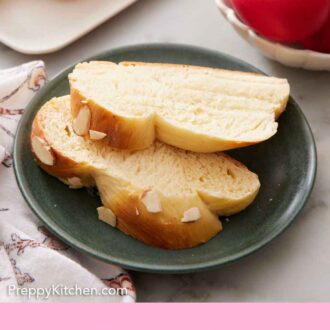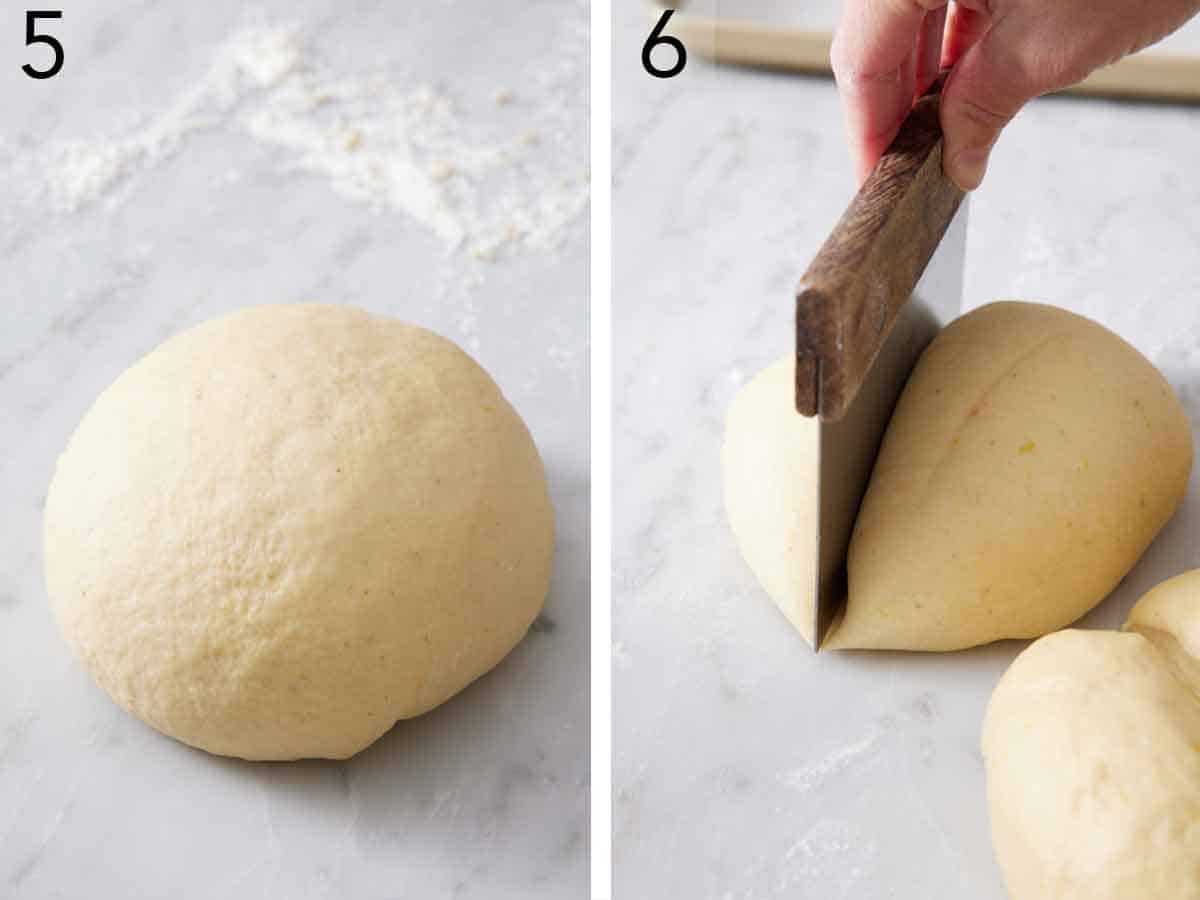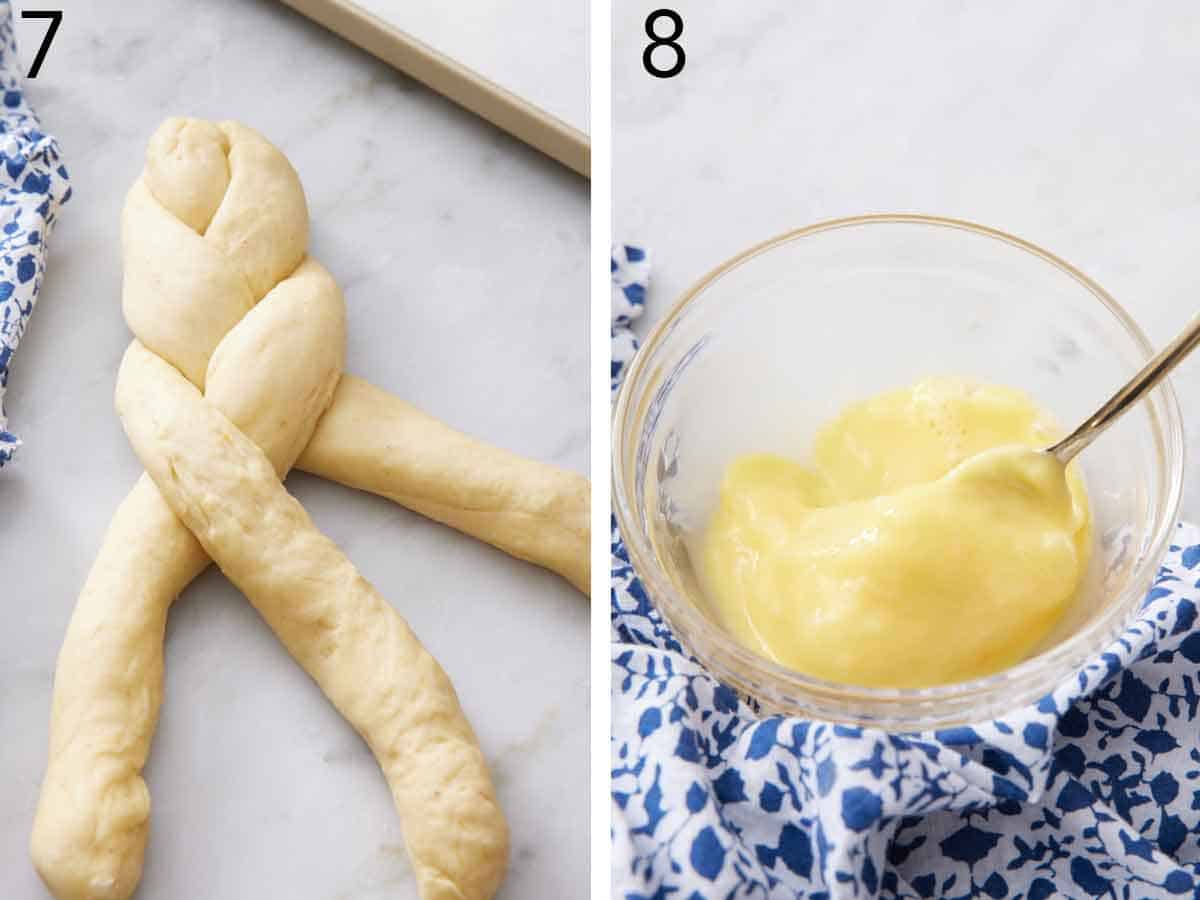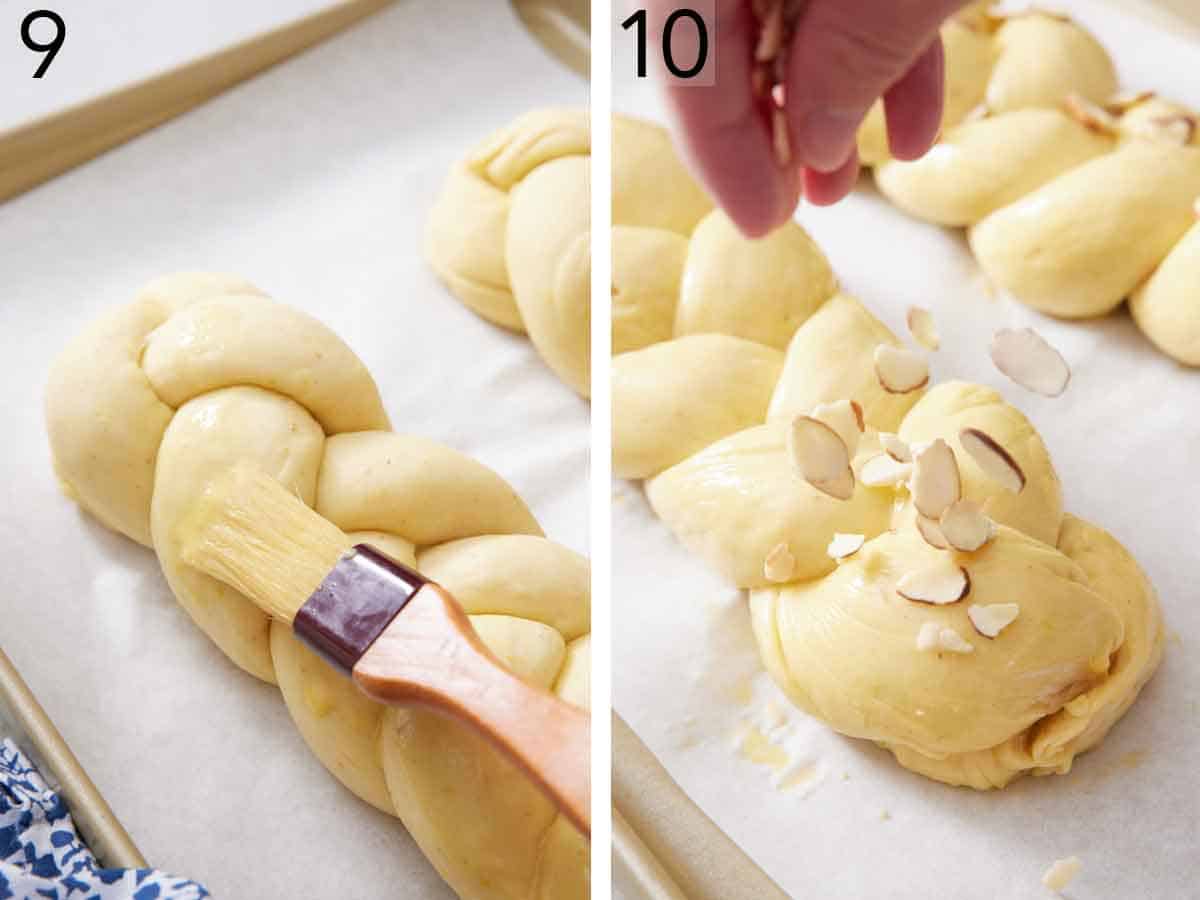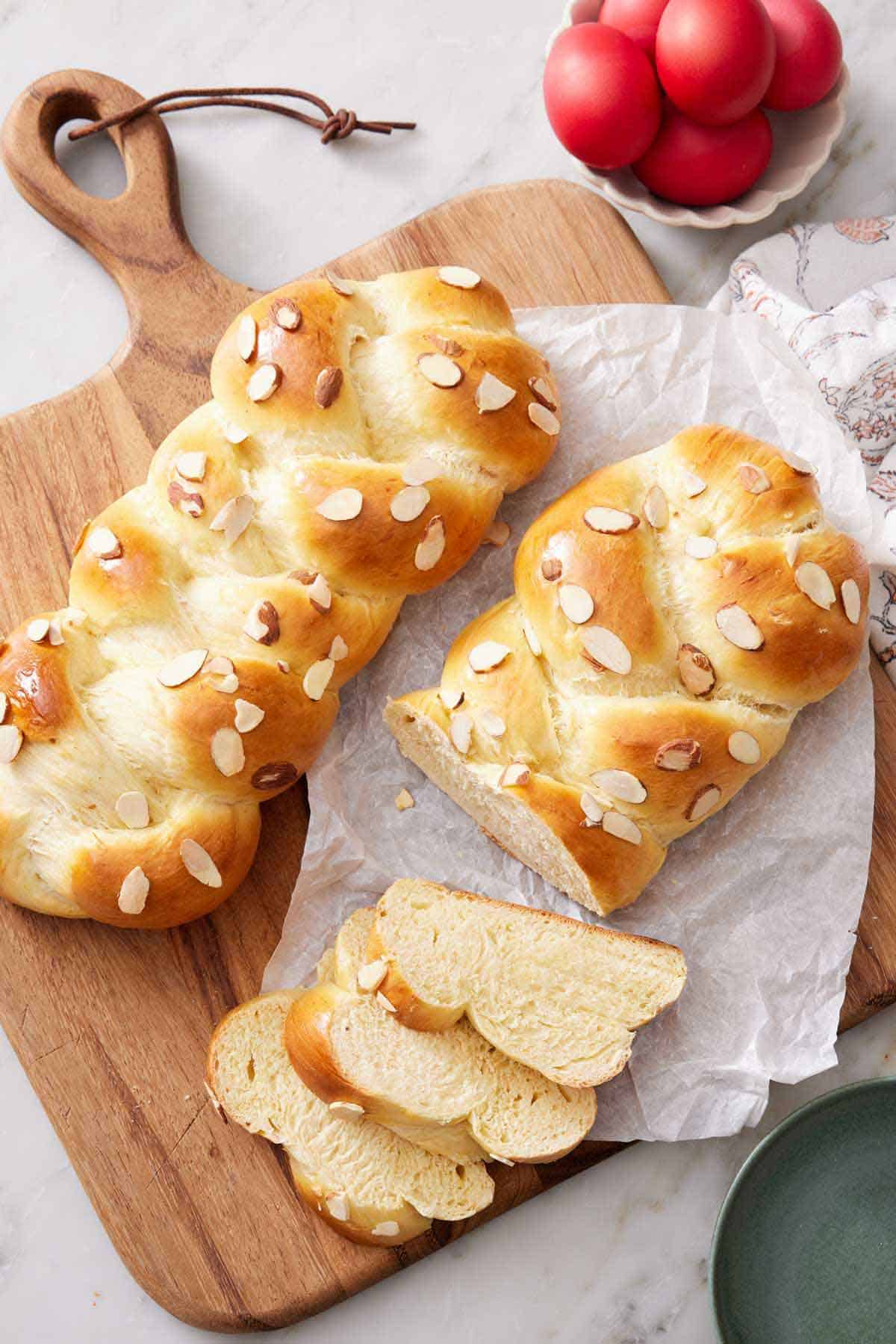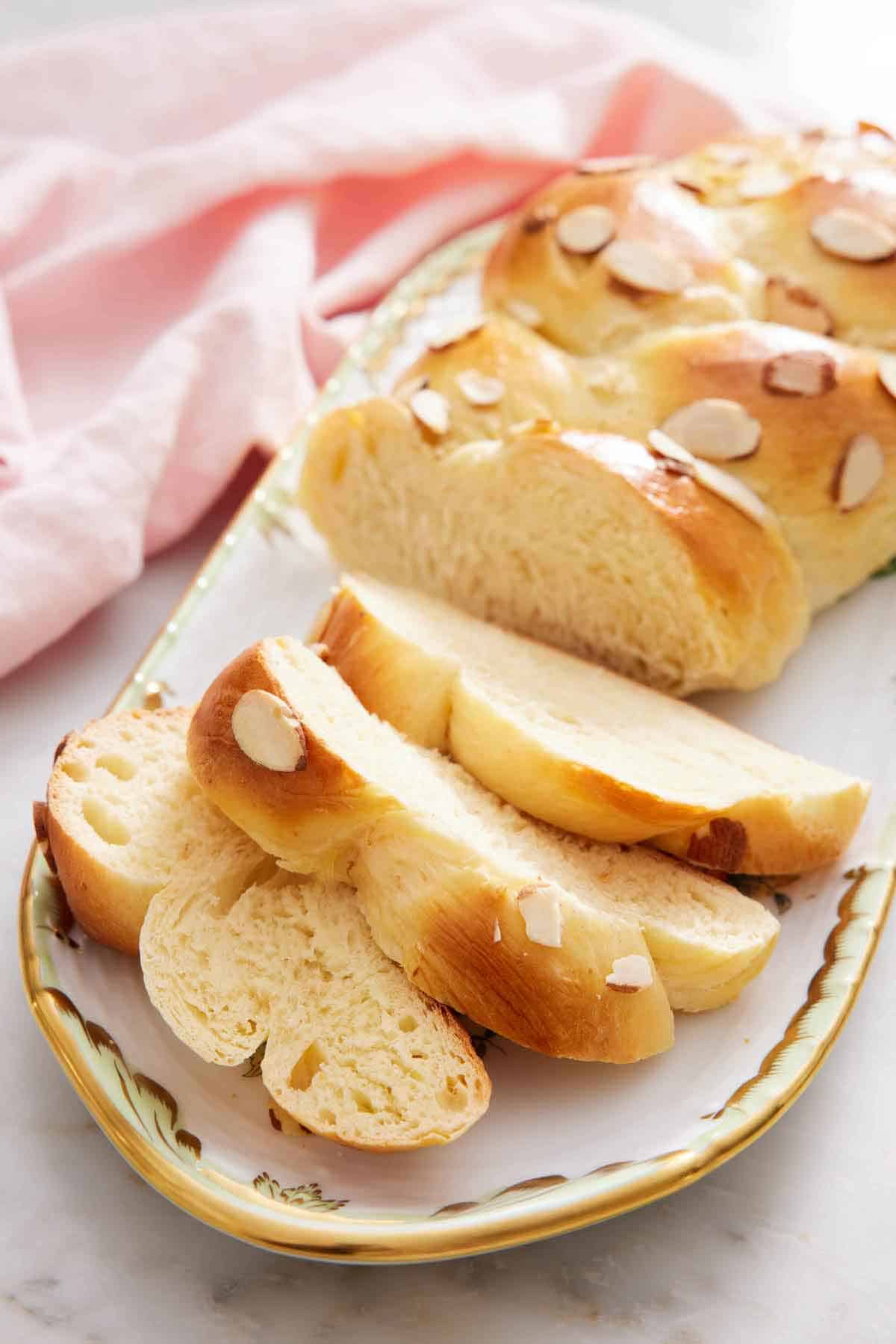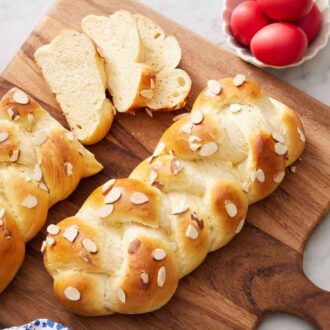Per tradition, this Greek Easter bread recipe is made with three braided pieces of dough to represent the holy trinity and served on Easter Sunday. In Greek culture, the loaves are often decorated with dyed, hard-boiled red eggs on top, or the eggs are placed on the braided dough before baking. But this recipe isn’t holiday-specific! You can enjoy Tsoureki as a delicious treat any time of year. If you’re looking for more bread recipes, try my Easter bread, Challah, or Italian bread recipe.
What You Need to Make This Recipe
Milk – whole milk is best as the fat content in the milk will enrich the dough and give the bread the lightest crumb with the richest flavor. Alternatively, you can use 2% milk. Butter – use unsalted butter so you can best control the saltiness of the recipe. Sugar – white granulated sugar gives the bread a light sweetness and helps lighten the texture. Active Dry Yeast– you can find dry yeast packets in the baking aisle of the grocery store. Be sure you use regular yeast and not rapid-rise or instant yeast. Eggs – use large eggs and bring them to room temperature before starting the recipe. You can soak cold eggs in warm water for 15 minutes to warm them up more quickly. Flour – I used all-purpose flour to give this Greek sweet bread a soft, fluffy texture. You can also swap in an equal amount of bread flour for a chewy loaf. Orange Zest – you will need the zest of one orange. Clean the orange well before using a fine grater or microplane zester to remove the outer layer of the orange peel. Mahlepi – this spice is native to the Mediterranean and parts of the Middle East and has a bitter-sweet flavor with notes of almond and cherry. You can find it at some specialty spice shops, online, and at Mediterranean grocers. Alternatively, you can use almond extract with great results. Mastiha – also known as mastic, mastiha is an aromatic tree resin used in cooking for its licorice-like flavor. If you cannot find it, you can substitute the same amount of ground anise seed for a similar flavor. Almonds – you will need sliced or slivered almonds to top the Tsoureki bread loaves. For an optional variation, you can use sesame seeds instead.
How to Make Tsoureki
- In a small saucepan, heat the milk, butter, and ½ cup of the sugar over medium-low heat, stirring occasionally until the butter is melted, for about 5 minutes. Remove the pot from the heat and cool until it is lukewarm (about 110°F), roughly 10 minutes.
- Meanwhile, in the large mixing bowl of a stand mixer, mix the water, yeast, and remaining 1 teaspoon of sugar until well combined. Let the mixture stand until it gets very foamy, 5-10 minutes.
- Add the warm milk mixture and eggs to the yeast mixture and whisk until combined.
- Add the flour, orange zest, mahlepi, salt, and mastiha. Attach the dough hook and mix on medium-low speed, stopping to scrape down sides of the bowl as needed, until a sticky and elastic dough forms, about 6 minutes.
- Place the dough on a lightly floured work surface and form it into a ball. Lightly oil the mixing bowl and place the dough ball back in it, turning to coat the dough all over with oil. Cover the bowl with plastic wrap and let the dough rise in a warm (75ºF), draft-free place until doubled in size, for about 1 hour to 1.5 hours.
- Line a large rimmed baking sheet with parchment paper. Punch down the risen dough with a closed fist and turn it out onto a lightly floured surface. Divide the dough in half using a sharp knife or a dough cutter.
- Working with one half at a time, cut the dough into 3 equal pieces, and roll each piece into a 12-inch long rope. Braid the ropes together. Tuck the ends under to keep the braid intact and place it on the prepared pan. Repeat with the remaining dough half. Loosely cover the dough with a clean dishcloth or plastic wrap and let it rise in a warm place (75ºF) until it is doubled in size, for about 1 hour. While the loaves are rising, preheat the oven to 350°F.
- In a small bowl, whisk together the egg and milk until smooth.
- Brush the risen loaves with the egg wash.
- Sprinkle the loaves evenly with almond slivers. Bake for 20-25 minutes or until the loaves are puffed and a deep golden brown. Transfer the Tsoureki loaves to a wire rack to cool. Serve warm or at room temperature.
Pro Tips For Making This Recipe
Use the right water temperature. Ideally, the water you add to the dry yeast should be around 105-110ºF. This is the best temperature to activate the yeast. If the water is too cold, the yeast won’t activate, and if it’s too hot, the yeast will die. Don’t add too much extra flour. The Tsoureki dough should be soft and tacky. You don’t want to make the dough too stiff with more flour, as it will make the texture of the baked bread dense instead of light and fluffy. So, when shaping the dough, only lightly flour it enough to keep the dough from sticking to your hands and the counter. Stop mixing the dough once it makes a slapping sound. You’ll know the dough is ready to remove from the mixer when it clings to the bottom of the bowl while also pulling away from the sides. As the mixer kneads the dough, it will make a light clapping sound as the dough slaps against the sides of the bowl when it is ready. Allow the dough to rise in a warm place. This is a crucial step for the Tsoureki dough to rise properly because the temperature must support the yeast’s growth. Make sure the dough is covered to prevent it from drying out and rests in a space that is 75ºF with no drafts – which change the temperature and create an uneven dough texture. If your kitchen is cold, you can place the bowl in a turned-off oven with the oven light on; the temperature inside is typically close to the suggested resting temperature. Use flavor substitutes! Don’t worry if you can’t find the traditional spices. The flavor substitutes given in the recipe (almond extract and anise seed) make a really delicious Tsoureki bread. Or, if you don’t like either of those flavors, use vanilla extract and another ground spice you like (cinnamon, cardamom, and fennel seeds would all be very tasty). While it may not technically be the traditional Greek Easter bread with other spices, it will be a great variation on it.
If you’ve tried this Tsoureki recipe, then don’t forget to rate the recipe and let me know how you got on in the comments below, I love hearing from you!



